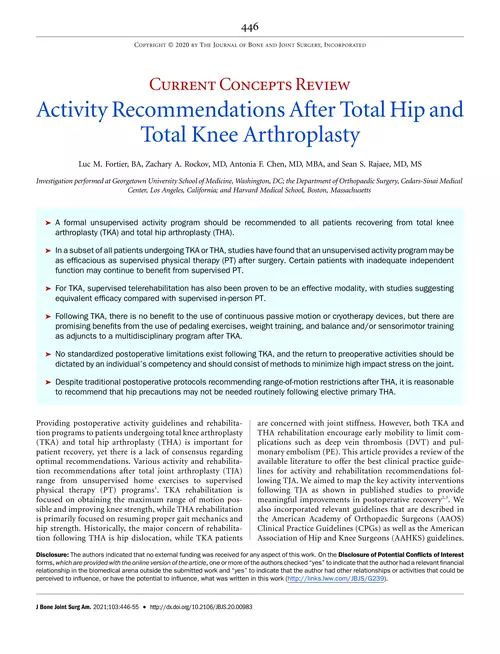
Activity Recommendations After Total Hip and Total Knee Arthroplasty
It is frequently related to hip weakness and instability standing on one leg. The exercises are listed in a progressive order. The first three can be started.
adsPart of the document
CurrentConceptsReview
ActivityRecommendationsAfterTotalHipand
Total Knee Arthroplasty
Luc M. Fortier, BA, Zachary A. Rockov, MD, Antonia F. Chen, MD, MBA, and Sean S. Rajaee, MD, MS
Investigation performedat Georgetown University School of Medicine, Washington, DC; the Departmentof Orthopaedic Surgery, Cedars-Sinai Medical
Center, Los Angeles, California; and Harvard Medical School, Boston, Massachusetts
?A formal unsupervised activity program should be recommended to all patients recovering from total knee
arthroplasty (TKA) and total hip arthroplasty (THA).
?InasubsetofallpatientsundergoingTKAorTHA,studieshavefoundthatanunsupervisedactivityprogrammaybeas efficacious as supervised physical therapy (PT) after surgery. Certain patients with inadequate independent
function may continue to benefit from supervised PT.
?For TKA, supervised telerehabilitation has also been proven to be an effective modality, with studies suggesting
equivalent efficacy compared with supervised in-person PT.
?Following TKA, there is no benefit to the use of continuous passive motion or cryotherapy devices, but there are
promising benefits from the use of pedaling exercises, weight training, and balance and/or sensorimotor training
as adjuncts to a multidisciplinary program after TKA.
?No standardized postoperative limitations exist following TKA, and the return to preoperative activities should be
dictated by an individual's competency and should consist of methods to minimize high impact stress on the joint.
?Despite traditional postoperative protocols recommending range-of-motion restrictions after THA, it is reasonable
to recommend that hip precautions may not be needed routinely following elective primary THA.
Providing postoperative activity guidelines and rehabilita-
tionprogramstopatientsundergoingtotalkneearthroplasty
(TKA) and total hip arthroplasty (THA) is important for
patient recovery, yet there is a lack of consensus regarding
optimal recommendations. Various activity and rehabilita-
tion recommendations after total joint arthroplasty (TJA)
range from unsupervised home exercises to supervised
physical therapy (PT) programs
1
.TKArehabilitationis
focused on obtaining the maximum range of motion pos-
sible and improving knee strength, while THA rehabilitation
is primarily focused on resuming proper gait mechanics and
hip strength. Historically, themajor concern of rehabilita-
tion following THA is hip dislocation, while TKA patientsare concerned with joint stiffness. However, both TKA and
THA rehabilitation encourage early mobility to limit com-
plications such as deep vein thrombosis (DVT) and pul-
monary embolism (PE). This article provides a review of the
available literature to offer the best clinical practice guide-
lines for activity and rehabilitation recommendations fol-
lowing TJA. We aimed to map the key activity interventions
following TJA as shown in published studies to provide
meaningful improvements in postoperative recovery
2,3
.We
also incorporated relevant guidelines that are described in
the American Academy of Orthopaedic Surgeons (AAOS)
Clinical Practice Guidelines (CPGs) as well as the American
Association of Hip and Knee Surgeons (AAHKS) guidelines.
Disclosure:The authors indicated that no external funding was received for any aspect of this work. On theDisclosure of Potential Conflicts of Interest
forms,whichareprovidedwiththeonlineversionofthearticle,oneormoreoftheauthorschecked"yes"toindicatethattheauthorhadarelevantfinancial
relationship in the biomedical arena outside the submitted work and"yes"to indicate that the author had other relationships or activities that could be
perceived to influence, or have the potential to influence, what was written in this work (


